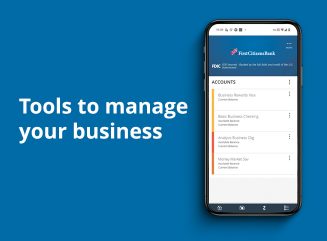Digital banking for business
Seamlessly access all of your accounts from one place with First Citizens Digital Banking for business.

Invest how you want, when you want, in real time with Self-Directed Investing.

Seamlessly access all of your accounts from one place with First Citizens Digital Banking for business.
We're committed to serving companies as they expand and succeed. The proof is in our success stories.
December FOMC meeting commentary: Available now
This month, the Fed lowered interest rates by another 0.25%. Read highlights and key takeaways from the Making Sense team.

Bank fraud is a criminal act that involves the use of deceit or deception to gain unauthorized access to funds or financial information. It can take many forms, including identity theft, phishing scams and account takeover. By working together, we can help ensure your financial information remains safe and secure.

Unique identifiers
You need a valid access code to access certain account and financial information.
Encryption
We use Transport Layer Security technology to ensure data is protected in transit.
Security alerts
Get notified when there's suspicious activity related to your account.
Timeout
Your session in our online application will automatically end after a period of inactivity.
Here are some steps you can take to ensure your account and personal information are as secure as possible.
Learn more about the types of information we collect, how we use it and how we work to protect your privacy.
Ensure your account contact information is up to date so we can quickly contact you about any suspicious activity.
Change passwords regularly, use different ones for different accounts and use a unique combination of letters, numbers and symbols.
This adds an extra layer of security to your account, making it more difficult for fraudsters to access it—even if they have your password.
Get real-time notifications about your account activity so you can detect and prevent fraud, as well as monitor spending and account balances.
Biometrics provide an added layer of security, making it more difficult for unauthorized individuals to access your account. Biometric authentication—such as a fingerprint—is unique to you and can't be replicated, making it a highly secure form of identification.
The best way to protect yourself from fraud is to arm yourself with knowledge on the most common types of scams.
Phishing is an attempt by fraudsters to lure you into emailing them your personal information so they can access your financial accounts. Red flags include:
Smishing is phishing through text, where scammers ask you to give away sensitive information or funds. To protect yourself from a smishing attack:
It's important to recognize some of the most common fraudulent messages and report them accordingly. These include:
While phishing and smishing are among the most common types of scams, there are a few more types that target customers:
Scammers can make text messages and emails appear that they're from First Citizens. To protect yourself from these threats:
Remember that we'll never text, email or call you to request security codes or other sensitive personal information.
A vague text from an unknown number. An alarming phone call from your bank. A phone call or a message about debt that's old or unfamiliar. A sense of urgency or threats—or a request to send money or pay debt using an unusual payment method. All of these are red flags that you might be dealing with a scammer. While it used to be much easier to spot a scam, fraudsters have started to evolve their tactics—and their scams are becoming increasingly sophisticated. That's why when it comes to fraud prevention, vigilance is key.
Here's how to protect yourself.
First, keep an eye out for those red flags, as well as any demands for secrecy or threats of arrest, embarrassment or blackmail. Also, any request involving payment via wire transfer or the purchase of gift cards or cryptocurrency should be an immediate red flag. Criminals prefer these methods because they're difficult to trace.
Next, remember that government agencies like the IRS and FBI won't contact you by phone to discuss unpaid taxes or other sensitive matters. If you're contacted about any type of debt, ask the caller to validate the debt in writing. This is a legal requirement from the Consumer Financial Protection Bureau that any legitimate debt collector will adhere to. If someone is harassing or threatening you, block them, and be sure to report any additional emails, text messages or phone calls you may receive.
Finally, know that your bank will never contact you and ask for your PIN, password or verification code. If you receive an unsolicited text or phone call that appears to be from your bank, do not provide any information or click on any links. Instead, hang up and call your bank using the number on the back of your card.
And always remember: If something doesn't add up or if you're being pressured—particularly if there's money involved—just stop engaging.
For more fraud prevention tactics, visit FirstCitizens.com/fraud-prevention.


Visit IC3.gov to access the FBI's centralized hub for reporting cybercrimes.
Learn where to report a scam through USA.gov.
Report and recover from identity theft through IdentityTheft.gov.
Visit any one of our bank branches to discuss potential fraud activity or identity theft in person.
Yes. Your deposits at First Citizens are protected up to at least $250,000 by the FDIC.
As added assurance, we have a banking history that spans more than 125 years. As one of America's largest family-controlled banks, we're known for our stability, financial discipline and long-term focus. Our time-tested strategies ensure that we'll be here for you both now and in the future.
We take protecting your personal information seriously and use state-of-the-art security technology to safeguard your account information. There are also some simple steps you can take to increase the security of your personal information.
The first thing you can do is to use strong passwords and user IDs. Hackers always go for the most obvious passwords and login IDs. So think of a phrase, song lyric or quote and add a few capital letters, numbers and symbols. And never use personal information such as family names, birthdates or phone numbers.
It's also important to not share your personal information to anyone who contacts you by phone, web, email or text message. Personal information includes your Social Security number, account numbers or any other information that can be used to personally identify you.
To report suspicious activity, contact us immediately at 866-567-7760.
You can also place a security freeze on your credit file to prevent fraudsters from opening new accounts or making changes to your existing accounts. You only need to notify one credit bureau—the one you choose will notify the other credit bureaus.
If you receive a suspicious email or text message, don't respond, select links or open attachments. If we reach out to you by phone, we won't ask for confidential information like your card PIN, access code or online banking password.
Be on the lookout for phone calls, emails or texts from even seemingly legitimate companies that either solicit your assistance or offer to help. Never give out your Social Security number, bank account numbers or other personal information to companies or individuals unless you initiated the conversation.
Links to third-party websites may have a privacy policy different from First Citizens Bank and may provide less security than this website. First Citizens Bank and its affiliates are not responsible for the products, services and content on any third-party website.
Bank deposit products are offered by First Citizens Bank. Member FDIC and an Equal Housing Lender. icon: sys-ehl.
NMLSR ID 503941

Treasury & Cash Management
Electronic Bill Presentment & Payment
Investment & Retirement Services
Community Association Banking
Equipment Financing & Leasing
Credit Cards
Merchant Services
Email Us
Please select the option that best matches your needs.
Customers with account-related questions who aren't enrolled in Digital Banking or who would prefer to talk with someone can call us directly.